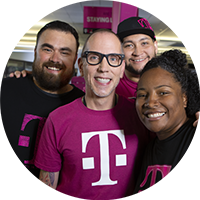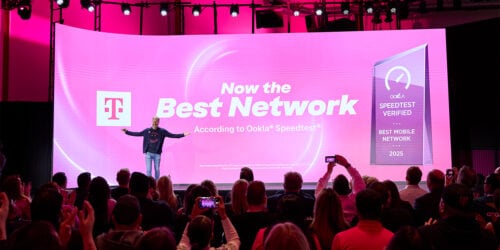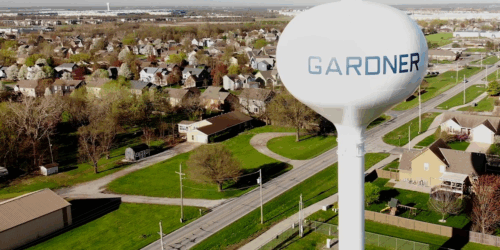Late last month, I had the privilege of getting on stage to share a milestone years in the making. In the most comprehensive network test ever conducted in the U.S., T-Mobile was named the Best Mobile Network in America.
If you’ve followed our journey, you know how monumental that is. When I joined T-Mobile in 2012, we had the worst network in the country. We were losing customers, losing revenue and losing relevance. In the wireless industry, where improvements are typically slow and incremental, our transformation was anything but expected.
But what makes this moment so meaningful isn’t just the outcome, but the journey that got us here.
We Flipped the Industry Playbook
Back in 2013, the top exec from the nation’s best network at the time famously said:
“With unlimited, it’s the physics that breaks it. If you allow unlimited usage, you just run out of gas.”
This quote perfectly captures the prevailing mindset of the legacy carriers at the time. Their networks were built for voice calls — a world where usage had a theoretical ceiling. After all, there are only so many people and only so many minutes in a day. The equation was easy to model, monetize and manage.
But the world was changing. Fast. Smartphones were becoming indispensable. Data usage was exploding. Customers didn’t want to count megabytes or gigabytes — they just wanted to use their devices freely.
While the legacy carriers asked, “How much should we let customers use?”, T-Mobile asked a different question: “How fast can we build a network that keeps up?”
Customers Now Write the Rules
The legacy carriers built their networks on a simple equation: constrain supply, and then charge more for less. Their investment strategies were designed to maximize return on investment by tightly controlling, and charging a premium for, a metered product. In the voice era, that worked. Usage was finite. The model was predictable and profitable. So they stuck with it.
But in the data era, that model collapsed. Demand wasn’t finite anymore. It was exponential. Every new app, screen and service layered on more usage. Customers weren’t asking for limits. They were demanding freedom. Unlimited access. Everywhere.
So the Un-carrier did just that. Our customers told us what they needed, and we figured out a way to get it done. But how did we do what the largest and most successful carriers of the time said was impossible?
Rather than charging more for less, we focused on delivering more for less. Instead of asking, “How much can we make per gigabyte?” we asked “How can we deliver each gigabyte more efficiently?”
That single shift in thinking changed everything and became the heartbeat of our entire Un-carrier strategy.
A 5G Fork in the Road: Once-in-a-Generation Opportunity To Leapfrog Into Leadership
Nowhere was our strategic divergence more visible than in the early days of 5G.
Legacy carriers faced a new generation of network technology, but responded with an old playbook.
Presumably, from looking at usage on their own networks, they saw dense traffic in a few hotspots. But those usage signals weren’t organic; those signals were filtered through the very limitations they imposed. So they made the wrong bet on a technology centered on “millimeter wave” radio spectrum — fast but limited, expensive and hard to scale. And they tried to charge a premium for it.
We saw something different. We saw 5G not as a reason to revisit old models, but as an opportunity to invent a new one.
By this point, we had already redefined how to scale a network: lower the cost per bit, serve growing demand efficiently, and invest in breadth, not just pockets of speed. A multilayered network centered on mid-band spectrum, not millimeter wave spectrum, would make this possible.
So, we pursued an unprecedented merger with the largest holder of mid-band spectrum, Sprint. The Sprint merger unlocked massive mid-band spectrum assets to take our approach to the next level. Suddenly, the philosophy we’d proven in 4G had the scale, efficiency and momentum to permanently shift how networks would be built.
It wasn’t just a better approach for T-Mobile’s customers, but for all wireless customers, as the rest of the industry is now attempting to follow our approach. Today, the mid-band centered and multilayer 5G network pioneered by T-Mobile is the envy of the 5G world. Widely emulated, but never quite duplicated. Our rivals spent tens of billions to try, but have still failed to catch up to T-Mobile’s multiyear lead in 5G spectrum deployed, macro cell site density and advanced 5G technologies designed to squeeze more performance out of each capital dollar and each slice of spectrum.
The result? A world that’s better connected, with T-Mobile customers the best-connected of all.
From Catching Up to Setting the Pace: Moving More Data per Day Than We Did per Year, Just a Decade Ago
Since 2012, we’ve invested nearly $200 billion into our network, business and spectrum. And today, our network moves more data in a single day than it did in all of 2012. Typical 5G speeds on our network, the fastest in the USA by far, now rival wired home broadband speeds and are actually faster than the Wi-Fi that customers experience the majority of places they go. And with T-Satellite launching this month, we’ll begin covering the 500,000 square miles no wireless network reaches today (that’s the size of California, Texas and Florida combined!).
Customers made it clear what they wanted. And T-Mobile network leadership didn’t happen because we were smarter. It happened because we listened — and our team found a way to make it happen. This culture of listening and responding with humility, relentlessly pursuing our goals, and never settling is what I believe is our biggest competitive advantage — an advantage I spend most of my time trying to reinforce, and the reason I believe we’ll stay ahead for years to come.
Our mission is simple: to be the best in the world at connecting customers to their world.
That mission constantly pushes us forward — whether that means redefining what a wireless provider does, or finding new ways to solve old problems. We’ve made truly historic progress, but if there’s one thing our customers remind us of every day, it is that this work is never finished.
Therefore … (wait for it) … We Won’t Stop!





